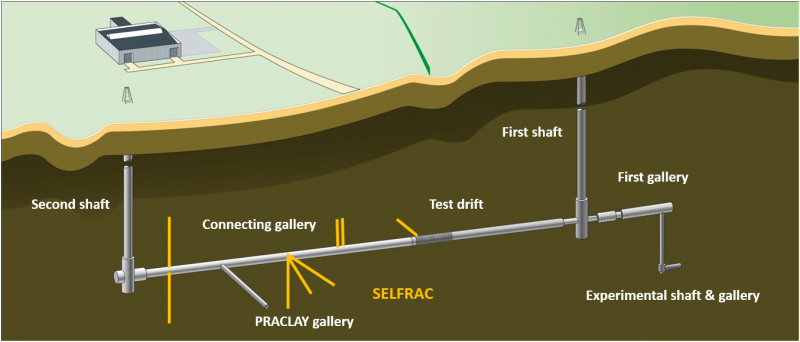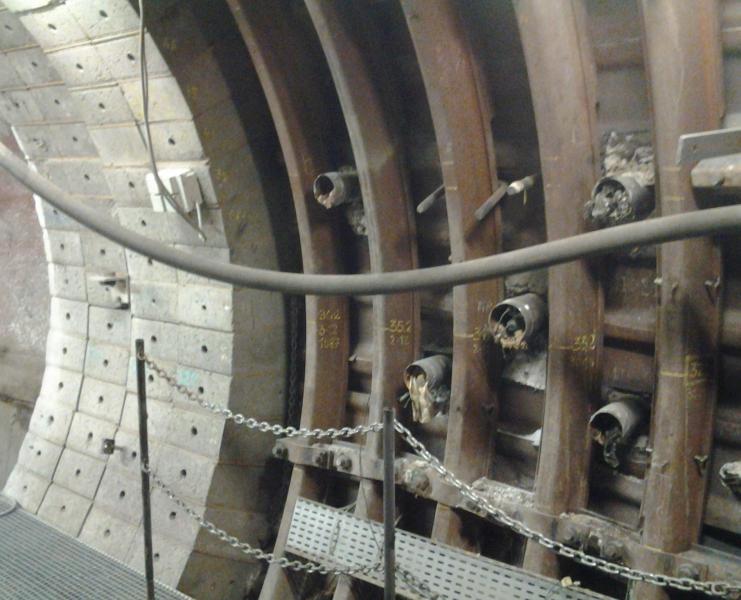SELFRAC (2001 - 2004)
 |
 |
Fractures and self-healing within the excavation-disturbed zone in clays
In Belgium, the proposed solution for long-term management of high-level and long-lived radioactive waste is geological disposal in poorly indurated clay. The clay host rock plays a crucial role for the long-term safety of people and the environment. After degradation of the engineered barriers around the waste packages, the clay host rock must continue to contain the waste safely and retard the migration of radionuclides towards the biosphere.
The construction and operation of an underground repository will inevitably cause “damage” in the surrounding host rock, which might have an impact on the migration of radionuclides that enter the host rock after degradation of the engineered barriers. More specifically, excavation might significantly increase the rock’s permeability, related to diffuse and/or local crack proliferation in the material. Self-sealing properties of clays can in turn reduce permeability over time. A proper evaluation of the Excavation-Damaged Zone (EDZ) near the repository and its hydro-mechanical and geochemical evolution with time is therefore needed.
The SELFRAC project was carried out as part of the 5th Framework Programme of the European Commission (FIKW-CT2001-00182) and coordinated by EIG EURIDICE. Two different potential geological formations for deep radioactive waste repositories were investigated by means of laboratory tests combined with in-situ tests: the indurated Opalinus Clay at Mont Terri (Switzerland) and the plastic Boom Clay at the HADES URL (Belgium).
OBJECTIVES
The SELFRAC project aims to properly characterise the Excavation Damaged Zone and its evolution with time. The main objective is to understand and quantify the fracturing, sealing and healing processes and to assess their impact on the performance of radioactive waste repositories.
For the Boom Clay, various in-situ experiments have been performed in HADES:
- EC SELFRAC in-situ test III: Evaluation of the evolution of the Excavation-Damaged Zone around the Connecting gallery, using two parallel piezometers;
- EC SELFRAC in-situ test IV: Evaluation of the evolution of the Excavation-Damaged Zone around a partially cased borehole using seismic and acoustic measurement techniques;
- In-situ permeability tests using filters installed in the boreholes drilled from Ring 55 of the Connecting gallery to monitor the self-sealing process around the Connecting gallery.
OUTCOME
Firstly, since no international consensus existed, the SELFRAC consortium proposed new definitions for concepts such as “Excavation-Damaged Zone” (EDZ), “Excavation-disturbed Zone” (EdZ), “Sealing” and “Healing”.
Secondly, the results of the HADES in-situ experiments clearly show that healing (partial) and sealing processes occur in situ in the Boom Clay. Sealing (and healing) is the result of several mechanisms, such as swelling, consolidation and creep. This means that the extent of the EDZ reduces with time.
SUMMARY
REFERENCE PUBLICATIONS
Bernier F., Li X. et.al. SELFRAC: Fractures and self-healing within the excavation disturbed zone in clays, Final report, European Commission, CORDIS website, EUR 22585, 2007, 56pp.
Bastiaens W., Bernier F., Li X. SELFRAC: experiments and conclusions on fracturing, self-healing and self-sealing processes in clays: 2nd International meeting "Clays in Natural & Engineered Barriers for Radioactive Waste Confinement”, TOURS, France, 15-18 March 2005. In: Physics and Chemistry of the Earth, 32:8-14(2007), pp. 600-615. ISSN 1474-7065
